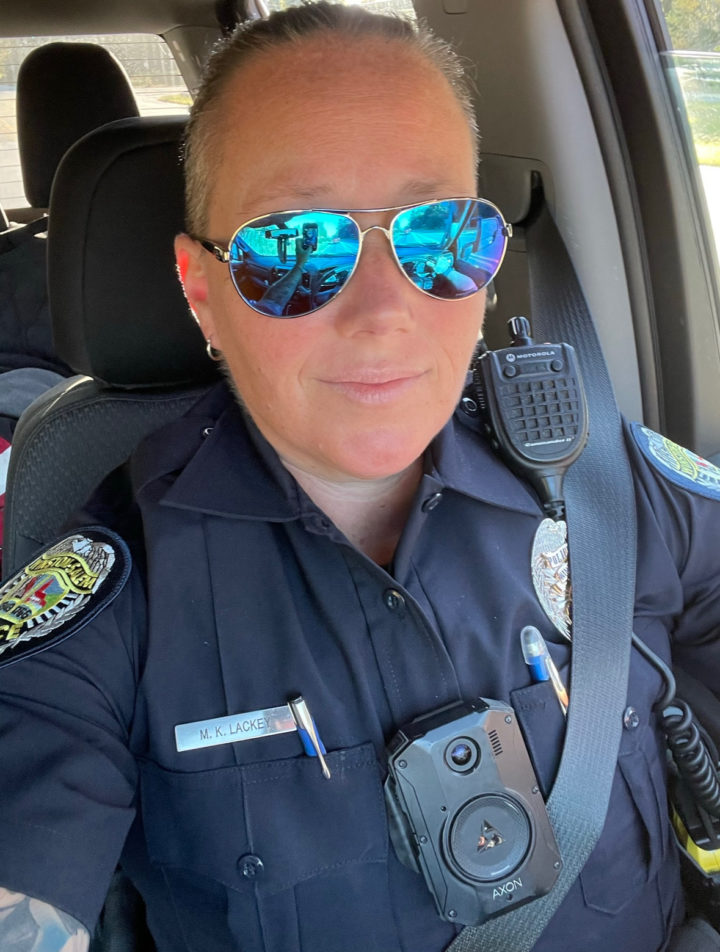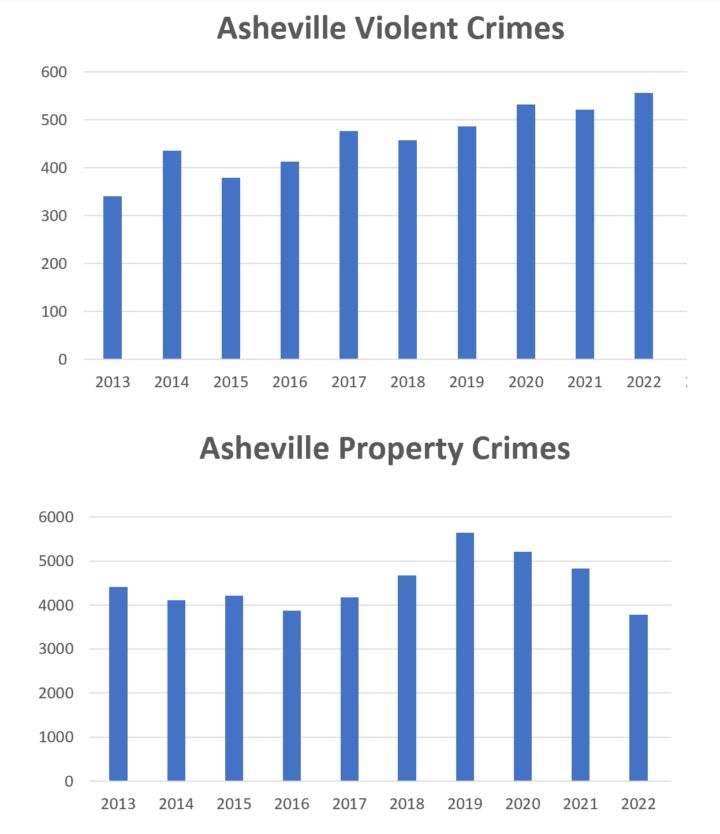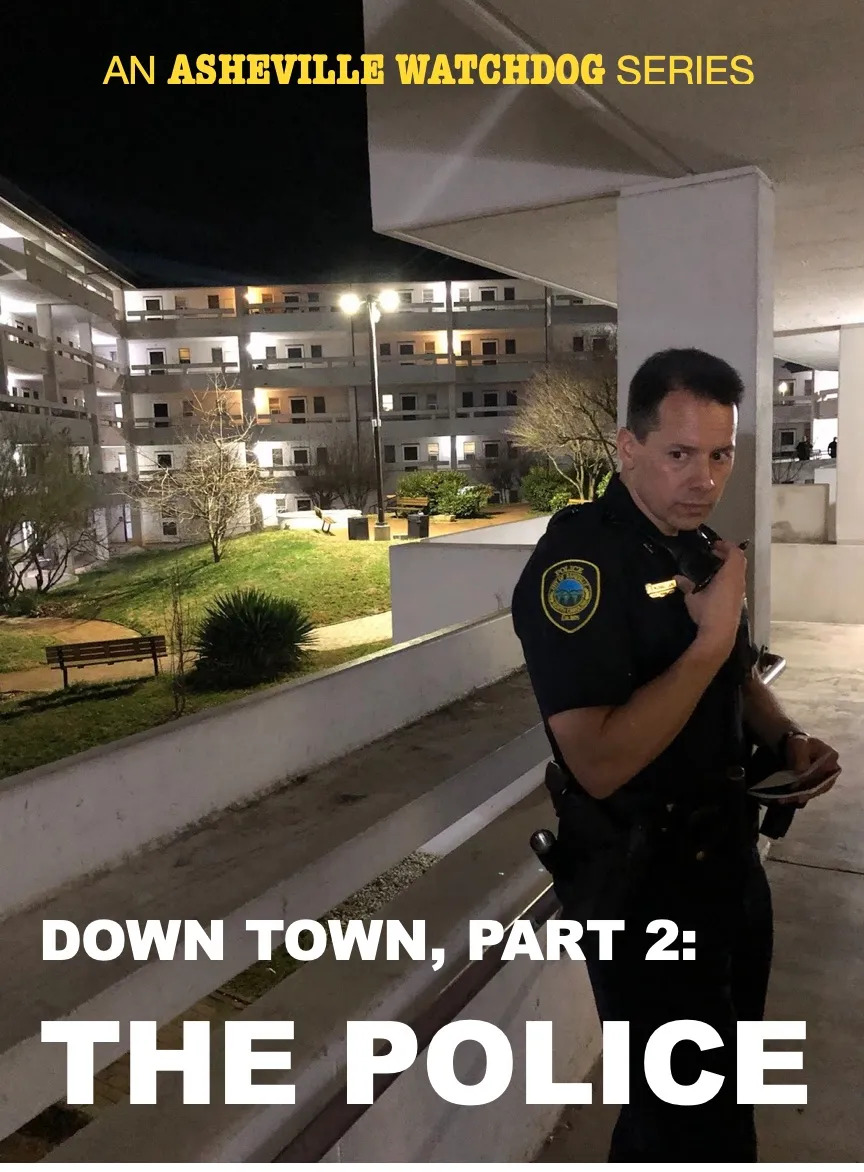By John Boyle, Sally Kestin and John Maines, avlwatchdog.org
On an ordinary day in Asheville, 16 to 18 police officers patrol the entire city, an area covering 46 square miles.
That’s down from 30 cops on duty three years ago, when Asheville first started losing officers faster than it could replace them.
The Asheville Police Department has been operating at a reduced capacity, now just 60%, for more than two years — and the Police Chief, David Zack, told Asheville Watchdog that it could be another decade before the force returns to pre-pandemic levels.
The shortage is at least partly due to the same affordability crisis at the root of many of the problems police are tasked with addressing. Fewer than one in five Asheville police officers actually live in Asheville, where the median sale price for a home was $445,000 in January, and the median rent for a two-bedroom apartment was $1,657.
Today, Asheville Watchdog continues its series Down Town, with an examination of the impact of a diminished police force especially downtown, where — as The Watchdog reported in Part 1 — merchants and residents have complained of increased break-ins and shoplifting, of human waste and needles in doorways, and of aggressive panhandlers.
Police patrols citywide are down. In the city’s core, officers on bicycles are gone, the Haywood Street police substation was closed in 2020, and downtown staffing has shrunk from eight cops per shift to two.
Asheville police Capt. Mike Lamb said that 20 years ago, when Asheville had about 20,000 fewer residents, the city had 255 officers. As of March 1, the number trained and available to work was 142.
City Manager Debra Campbell, Zack’s boss, described the impact of the officer shortage to the City Council in an Aug. 16, 2022, memo.
A traffic safety unit with seven officers had been “temporarily disbanded as only a single officer and sergeant remained,” she wrote. “Serious accident investigation will be handled by less qualified patrol officers … Proactive traffic enforcement, which has already been greatly curtailed, will be reduced even further. Neighborhood traffic concerns (stop sign, speeding, loud muffler etc.) will also receive limited attention.”
A police unit dedicated to public housing, where violent crime is the highest in the city, was disbanded because five of the eight officers left. The other three were reassigned to a team focusing on violent crime, Campbell wrote.
And the community engagement team, headed by Lamb and created to deal with many of the issues generating complaints downtown, had lost all eight of its officers. The department, Campbell wrote, “will no longer have officers exclusively assigned to respond to … illegal camping, panhandling, illegal parking, drug complaints, graffiti and trespassing.”
2020: A pivotal year
To some in Asheville, a shrunken police force is cause for celebration. In the summer of 2020, following the murder of George Floyd by police officers in Minneapolis, thousands of protesters assembled in cities nationwide including downtown Asheville, calling for an end to traditional policing that too often had culminated in violence, particularly against people of color.

A “Defund the Police” movement arose, calling for elected leaders to dilute the power and size of police departments and shift responsibilities to others with more training on the root causes of crime, such as mental health, poverty and drugs.
The Asheville City Council responded with a commitment to reparations for Blacks, who had endured decades of systemic racism in criminal justice and other areas. The City Council solicited public input on “Reimagining Public Safety” and decreased the total number of positions in the police department from 314 in 2020 to 269 the past two years, shifting some jobs away from police to other departments to handle calls such as animal control and noise complaints.
Within about a year of the George Floyd protests, 80 Asheville officers — one-third of the force — had retired or quit, an exodus that made Asheville the focus of a July 2021 article in The New York Times headlined, “Why Police Have Been Quitting in Droves in the Last Year.” Officers who had found themselves facing off against protesters complained that they had lost support from the City Council and Campbell, who oversees the police department.
Former Asheville Police Sgt. Melissa Lackey, 44, is one of those who left. She’s now a police officer in Winston-Salem. Lackey spent 10 years in Asheville but left in August, citing the pay, the high cost of living, a sense that she’d never get off night shift — and what she felt was a lack of support from city officials.
Lackey said she makes more in Winston-Salem as an officer, $66,000, than she did as a supervisor in Asheville earning about $60,000 a year. She said she also received a $10,000 signing bonus from Winston-Salem.
Lackey said she felt unsafe in Asheville, particularly downtown after June 2020, when the George Floyd protests escalated into near-riots. She said she had been attacked two years earlier, in 2018, by a man with a knife as she sat in her patrol car in front of the now-closed Haywood Street downtown police substation.
“But it wasn’t until after 2020 that I was terrified,” she said. “I was like, ‘I don’t want to go downtown.’ ”
Policing: A political hot potato
Policing remains a political hot potato in Asheville. Anti-police symbols have been spray-painted on buildings. Asheville police were widely criticized for destroying an aid station set up to provide water and first-aid to the protesters in 2020. More protests followed the Christmas Day 2021 eviction of unhoused people and their advocates from a downtown park.

Many say the smaller, less visible police force contributes to a perception that downtown and other parts of the city are less safe. But the concept of returning to more cops rankles others, particularly on the far-left.
In a recent Twitter post critical of merchants’ complaints as portrayed by Asheville Watchdog, Firestorm Books & Coffee in West Asheville, self-described on its website as “a hub for anarchist thought and culture in WNC,” cited a New York Civil Liberties Union article from March 2022 titled, “We can’t police our way out of homelessness and mental health.”
The article stated, “The response from many policymakers is predictable: More police, more coercion of people with mental illness, and — at best — only nods to the deeper problems that cause homelessness, mental health crises, and violence.”
On the other side of the spectrum, right-leaning Fox News has several times portrayed Asheville as one of the most dangerous cities in America, blaming the city’s left-leaning politicians. “CRIME SOARS IN DEM-RUN TOURIST TOWN,” said one chyron. Another chyron proclaimed “TOWN BECOMING HUB OF ANTIFA”.
“If you want to be a bum, just come to Asheville and life will be good,” Asheville resident Helen Hyatt of the Coalition of Asheville Neighborhoods said on a March 3 segment of Fox & Friends.
Asheville, Hyatt told the national audience, has become “completely lawless.”
Safety, in numbers
To many residents, Asheville does feel less safe.
Residents of the city’s public housing developments report being afraid in their homes because of gun violence. Downtown merchants and residents say they see more erratic behavior, including yelling, illicit sex, and defecating in public spaces. Used drug needles litter some sidewalks.
People living on the streets say they, too, are afraid and have been robbed and assaulted.
Zack, in a recent interview at police headquarters, said most of the city’s crimes occur downtown, but the more serious crimes — violent assaults and homicides — are predominantly in the city’s public housing developments.
Asheville native Whitley English, 34, lived in Deaverview Apartments in West Asheville for 10 years but moved to the newly constructed Maple Crest public housing apartments off Biltmore Avenue near downtown two years ago.
English said she understands crime is a problem in all parts of town, including downtown, but she noted that Maple Crest has had three homicides since July. That includes a double homicide in late February.
English has a 13-year-old daughter, and the shootings have them on edge.
“I don’t feel safe at all,” English said. “The police know what’s going on, but there’s nothing being done, so I don’t I don’t know what to say. I guess it’s fend for yourself — figure it out for yourself.”
English said having an officer stationed at Maple Crest would help.
“I think by having the police presence around, crime wouldn’t be as bad as it is,” she said. “But first off, it would be a relationship with the community — building a better relationship with the community and the police force.”
At a March 3 meeting of downtown business owners, Asheville police Capt. Lamb said “Everybody wants officers everywhere, between communities, businesses, different areas that are having criminal issues. We’re getting a consistent demand across the city that wants to see more officers.”
“Presence deters crime”
The chief said he has heard complaints for two years about the lack of a police presence downtown, as well as “concerns about homeless and just the overall feeling of safety downtown.”

“Presence deters crime — there’s no doubt about it,” Zack said. “People can debate how much of an effect it has. Quite frankly, we know when you [see] officers downtown — and a lot of this is perception, too — when you see officers and you’re a shop owner or a business owner, you have a level of comfort.”
The 16 to 18 officers on duty at any time are divided among three police districts: Adam for the city’s north and east sides, Baker covering mostly West Asheville, and Charlie/David combining downtown and the Biltmore Village area.
Downtown used to be its own district, Charlie, with eight full-time officers and two to three additional on duty for each 12-hour shift, Lamb said. Now, “we have two officers and maybe two working extra.”
Some have suggested pulling officers from other districts to reinforce downtown, Zack said. But that’s not an option, he said, because of the need to respond urgently and safely to critical calls.
“These gunshots and shots fired [calls], they’re occurring all over,” Zack said. “And when they do occur, somebody’s got to go, and somebody’s got to get there and they got to get there safely, and in sufficient numbers to deal with whatever the threat might be.”
Certain calls strain police resources even further. “We had a guy the other night, he had warrants for his arrest and he would not get in the car, and it took seven officers about 30 minutes,” Lamb said at the March 3 business meeting.
Officers are paid overtime to work “augment shifts.” The department spent $681,626 on overtime in 2020, $813,842 in 2021, and $390,708 in 2022, and Zack said he is under “no pressure whatsoever” to reduce that cost.
The department is “constantly increasing the number of augment shifts to try and get more coverage and more of a presence downtown,” the chief said. But officers have been “burning the candle at both ends for two years … and it’s like, ‘How much more overtime can we make them work?’”
Crime trends mixed
Measuring how the perception of safety squares with reality is imprecise.
Asheville police incident data show that in the three years beginning in 2020, when the exodus of officers began, violent crime increased, driven by more aggravated assaults.
Property crimes dropped, mirroring a national trend resulting from more people being home during the pandemic and fewer reported burglaries and break-ins.
Two notable consequences of the decline in officers: From 2020 to 2022, Asheville police arrests were at their lowest in more than a decade, and police response times increased. Priority calls now take an average of eight minutes, compared to 6.8 three years ago, according to Asheville police records. It takes officers an average of 23.4 minutes for lower priority calls, compared to 19.9 three years ago.
Downtown, in the police beat known as Charlie 1, the picture since 2020 shows violent crimes climbing in 2021 and then dropping in 2022. Breaking and entering went up, and assaults were down.
Drug overdoses downtown nearly doubled, to 41 in 2022 from 21 in 2020.
Some of the crime statistics are likely under-reported. The police department announced in June 2021 that due to staffing shortages officers would no longer respond to a variety of non-violent crimes ranging from thefts under $1,000 with no suspect information, to fraud, scams and identity theft.
And several downtown business owners told Asheville Watchdog they stopped calling police because of how long it took for officers to respond — if they came at all — or they felt prosecution of the offenses would be ineffective.
Lamb, the police captain, noted that shop owners and employees at a recent public meeting said they’d seen people downtown acting aggressively with knives and clubs.
“That is something that we need to respond to, but we’re not getting a lot of those calls,” Lamb said at the meeting of business owners. “A lot of folks are not calling the police department because they think we will not respond.”
Trespassing incidents downtown have actually decreased since 2020, despite persistent complaints from businesses of people hanging out and sleeping in doorways and leaving human waste, trash and needles. A police program gives business owners the option of signing a “no trespassing” letter that allows officers to charge violators.
Only 38% of businesses downtown have “no trespassing” signs, and 20 percent have trespass letters on file, according to the police department. Without the letters, officers can’t force people to leave, Lamb said.
“If you’re concerned about trespassing at your establishment,” Zack said, “how about signing a letter that says, ‘We’ll prosecute for trespassing?’”
The recruiting problem
Replenishing the police force is a top priority for the chief, but recruiting new officers or luring cops from other departments is challenging. Asheville often ranks as the most expensive place in North Carolina to live.
Earlier this month the nonprofit Just Economics of WNC released its “living wage” calculation for 2023, which represents what the group said “would allow a single person working full-time to qualify for a one-bedroom apartment in the Buncombe County area.” The 2023 figure is $20.10 an hour, which comes to $41,808 a year.
The Asheville Police Department’s starting salary for police officer trainees is $42,548. It rises to $45,856 upon completion of the academy and state certification.
Of 174 officers on the force, Zack said, just eight own homes in the city limits, and another 19 rent apartments, mostly because it’s cheaper outside Asheville. The chief lived in the city limits his first year here, but he married recently and he and his wife own a home just outside the city limits. His wife owns a condominium downtown, and they stay there often, Zack said.
The city has boosted starting police salaries in recent years and added such perks as a $1,000 annual uniform allowance and a 5% pay increase for advanced law enforcement training, Zack said. But Asheville also has to compete with other police forces and sheriff’s offices in the state.
“I think we have to be more competitive with an agency like Charlotte, or the state police,” Zack said. He said he would like to see Asheville become a destination department, where officers want to spend their careers and would leave other departments to come here.
Entry level pay for the Charlotte-Mecklenburg Police Department is $51,465, and officers can earn up to $90,017, according to the website. For the North Carolina State Highway Patrol, the hiring salary is $46,058 and $49,516 upon graduation from Patrol School, according to the website.
Asheville Watchdog checked with other cities about staffing and vacancies in their police departments. The three that responded, Raleigh and High Point in North Carolina, and Greenville, South Carolina, all reported lower vacancy rates than Asheville — 6% to 15% — and more officers working the streets.
One patrol team of 15 to 16 officers and four supervisors is on duty at all times in High Point, a city with about 20,000 more people than Asheville, and for seven hours a day, when shifts overlap, the city has two teams with double the number of officers, police spokeswoman Victoria Ruvio said. The starting salary in High Point is $47,887 to $52,676, depending on education, she said.
Greenville, with about 22,000 fewer residents than Asheville, has 17 officers on patrol at any time plus 15 on specialized teams such as traffic and neighborhood engagement, Sgt. Johnathan Bragg said. Four to eight officers are assigned to the central business district, depending on the time of day, and more on weekends. The starting salary is $47,515.
In Raleigh, a city five times bigger than Asheville, the police department has a little over 100 vacancies out of 796 officers, or 13%. A spokesman said the department does not comment on staffing. The starting salary for an officer is $50,301.
Zack says Asheville has lost officers to the Buncombe County Sheriff’s Office, mainly because of pay. The Sheriff’s Office runs the Buncombe County Detention Center, and starting pay there is $48,353.
But Asheville has also lost officers to local agencies that pay less but have less stressful demands on officers, or that cut down on commuting time.
“I think we have to be not equal to everyone else — we have to be well ahead,” Zack said. “Ideally, I think you need to be for a starting salary, you need to be closer to $60,000.”
Speaking at an Asheville City Council retreat March 3, Zack went further: “We need to be the highest paid agency in the state.”
Zack said an Asheville senior police officer (three years of experience) now starts at $51,653 but should be $70,000.
Sheriff’s Office also struggling
Lamb said the department’s wave of resignations, as well as relatively low pay, drew the attention of other agencies looking to recruit Asheville officers, who often have more extensive training than other department’s officers.
“When the resignations began, other agencies saw it as an opportunity,” Lamb said. “So the sheriff, being an ex-APD officer, started reaching out, and the county bumped their pay up just enough to where it was higher than what we were paying. And also they offer a higher 401k investment percentage.”
Aaron Sarver, spokesperson for the Buncombe County Sheriff’s Office and Sheriff Quentin Miller, said the sheriff’s office does not have a “special effort geared toward” hiring from the Asheville Police Department.
“We’re actively recruiting officers and deputies from every agency in Western North Carolina,” Sarver said via email.
Asheville Watchdog requested the number of Asheville officers who have come to the sheriff’s office in the last three years, but Sarver said that information was not available from the human resources system. He estimated it to be “in the double digits.”
The total number of ex-Asheville officers at the Sheriff’s Office is higher. “A good number of people came over under (former) Sheriff [Van] Duncan as well and when Sheriff Miller took office” in 2018, Sarver said.
The Sheriff’s Office also has struggled to reach full staffing. It has 435 funded positions, but that includes about 30 non-sworn administrative positions, Sarver said. Currently, 356 of the 435 positions are filled, Sarver said.
More than half of the vacancies are at the county jail, the office’s largest division.
“While our staffing has improved in detention over the past six to eight months, like all correctional facilities in North Carolina, we continue to struggle to recruit for these positions,” Sarver said. “The job market and cost of living in Asheville/Buncombe County create additional challenges compared to other parts of the state.”
Can the TDA help fund more cops?
Some locals have called for the police department to receive money collected on the bed tax by the Buncombe County Tourism Development Authority, which currently, as dictated by state law, devotes two-thirds of its funds to marketing efforts and one-third to the Tourism Product Development Fund, which awards grants to permanent projects ranging from baseball fields to local theaters.
At its January meeting, the TDA noted that Buncombe County saw record growth in visitor spending in fiscal year 2022, and that in turn spurred an increase in lodging tax revenue, “reaching a historic $36.4 million.”
Victoria “Vic” Isley, president and chief executive officer of the Tourism Authority, said she has heard from downtown business owners, locals and tourists about break-ins, minor crime and uncomfortable encounters.
Some visitors are asking about smaller towns outside of Asheville and Buncombe, Isley said. “They’re talking about frequenting businesses that are outside of our core, and that’s concerning for the livelihoods of workers as well as businesses,” she said.
New legislation passed last year readjusted the TDA formula, reducing the marketing allocation and bumping up the allowable spending on tourism products, but it does not allow for funding police. Isley stressed that the “lodging tax isn’t a panacea.”
“It’s not going to fix every issue we have as a community, and we cannot fund operations,” she said.
For example, the Tourism Authority could fund such capital projects as larger and better trash cans downtown, but it can’t fund the employees who would empty them. Similarly, Isley said, the TDA cannot fund police officers.
“We can be partners in other areas, but [funding] for standing operations is not a legal use of the lodging tax,” Isley said.
But money is not the main problem anyway, Isley said.
“APD has a human resources issue,” Isley said. “For once, they don’t have a financial resources issue, and they’ve got to work on recruiting and building trust, and having the benefits and resources for retention of officers.”
Asheville police recovery could take a decade
Zack said it will be years before the police department returns to full staffing, unless it can attract transfers from other departments. And Asheville’s flow of officers has never gone that direction, Zack said. Far more officers leave Asheville and go to other departments than vice versa.
“Unless we were able to really attract lateral transfers, I put our recovery anywhere from five to 10 years, closer to 10,” Zack said, noting that training time to solo patrol is 14 months.
Asheville has 10 officers in training now, and the largest class the department could accommodate is 15 officers. With two classes per year, that would mean 30 officers annually, assuming they all stay with the program and pass state exams.
In 2020, one entire class of seven recruits quit before completing their field training, some going to other departments, some leaving policing altogether, Zack said.
Zack said the department now requires officers to stay for three years or repay some of their training costs, depending on when they leave.
Zack, who has served 36 years as a police officer, said recruitment was difficult even before 2020. The “glamour, or whatever you want to call it,” Zack said, started to evaporate in 2014, after the police killing of Michael Brown in Ferguson, Missouri.
About 15 to 20 officers retired or resigned each year for years, but that increased to 58 in 2020, the year of the George Floyd protests, and 23 to 38 each subsequent year, according to Zack.
“You’re always in the deep end, and you’re bobbing up and down trying to breathe,” Zack said.
The department has contracted with a recruiting firm for two years at a cost of $225,000. Asheville has to compete with other police departments not just on salary and benefits, but also on the community’s “reputation toward law enforcement,” Zack said.
By that he means an anti-police sentiment in Asheville. In 2020, protesters painted “Defund the Police” on a downtown street in bright yellow and marched behind signs that read, “Fund communities, not cops.” At another protest, a casket full of dirt and cow manure was delivered to the police station.
Zack said the pendulum may be shifting toward more support for police, now that business owners and downtown workers are complaining that a lack of police presence is contributing to safety and cleanliness problems.
“I think for the longest time, a small, loud minority was being heard. And now you’re seeing others have their voices heard,” Zack said. “The feedback that I’m getting from council is they are listening and they are hearing.”
Staff writer Andrew R. Jones contributed to this report.
Asheville Watchdog is a nonprofit news team producing stories that matter to Asheville and surrounding communities. Sally Kestin is a Pulitzer Prize-winning investigative reporter. Email skestin@avlwatchdog.org. John Boyle has been covering western North Carolina since the 20th century. You can reach him at (828) 337-0941, or via email at jboyle@avlwatchdog.org. John Maines was part of a team that won two Pulitzer Prizes, for Public Service in 2013 and 2019. Email: jmaines@avlwatchdog.org





“I think for the longest time, a small, loud minority was being heard. And now you’re seeing others have their voices heard,” Zack said. “The feedback that I’m getting from council is they are listening and they are hearing.”
That’s all this weak leadership running Asheville ever does. You continue to elect these people, you get what Asheville deserves.
Anyone who thinks the homeless problem in Asheville is going away -if and when more city police can be hired anytime soon- is living in la la land. Even with adequate staffing numbers on the police force, the ever growing number of homeless folks are not going away…. period. And while I’m at it… the Asheville police chief is right on spot about what the salary numbers need to be in order to recruit new patrol and police officers. And what does the city do instead? …it hires a head hunting firm for 225k to find those willing to work at our substandard wages for the new and experienced police officers. Guess what/ whom the headhunters will find other than substandard applicants… ??
Yep, we need higher salaries, higher standards, new/inventive community policing methods, community support, and a heavy dose of realism from residents and recruiters…waterfalls ain’t gonna cut it…police are trained to investigate and they all know that salaries are higher elsewhere when you factor in cost of living. Really seems like we’re nearing a crisis as this place keeps growing/developing/inviting tourists with reduced force and house not in order.
The number of officers is a joke and the deployment is a joke. The population is not spread uniformly throughout the city, nor are the tourists. So, what do you do? Close the downtown sub-station where the density is which featured walking/biking cops who actually had some rapport with the wide mix of people. You know, the cops who actually knew who the real bad guys are.
Oh well, OTOH, I haven’t stopped for an early red light, much less a yellow light in 2-3 years now. Odds of getting a ticket is precisely zero.
Why do Boyle et al, give special weight to the Firestorm whack jobs? All 8 of them.
Time to significantly raise police wages to get the force to the approved level. Time to redelpoy the force to where the crime is. Why’d we run from downtown like the cops did in Seattle? Time for the council to support the police. Time for Campbell to support the police , or exit.
Saying that we (Firestorm) were “critical of merchants’ complaints as portrayed by Asheville Watchdog” makes it sound like we were criticizing merchants when our criticism was actually directed at Watchdog’s coverage, which we called “copaganda,” “not neutral,” “designed to other and exclude,” “less like an attempt to tell a complete story than a grievance list,” an “inflammatory piece masquerading as investigative journalism,” and “[lacking] editorial discernment.” Please provide an inline link to our commentary so that readers can decide for themselves. It can be found at https://twitter.com/FirestormCoop/status/1630654092610510848